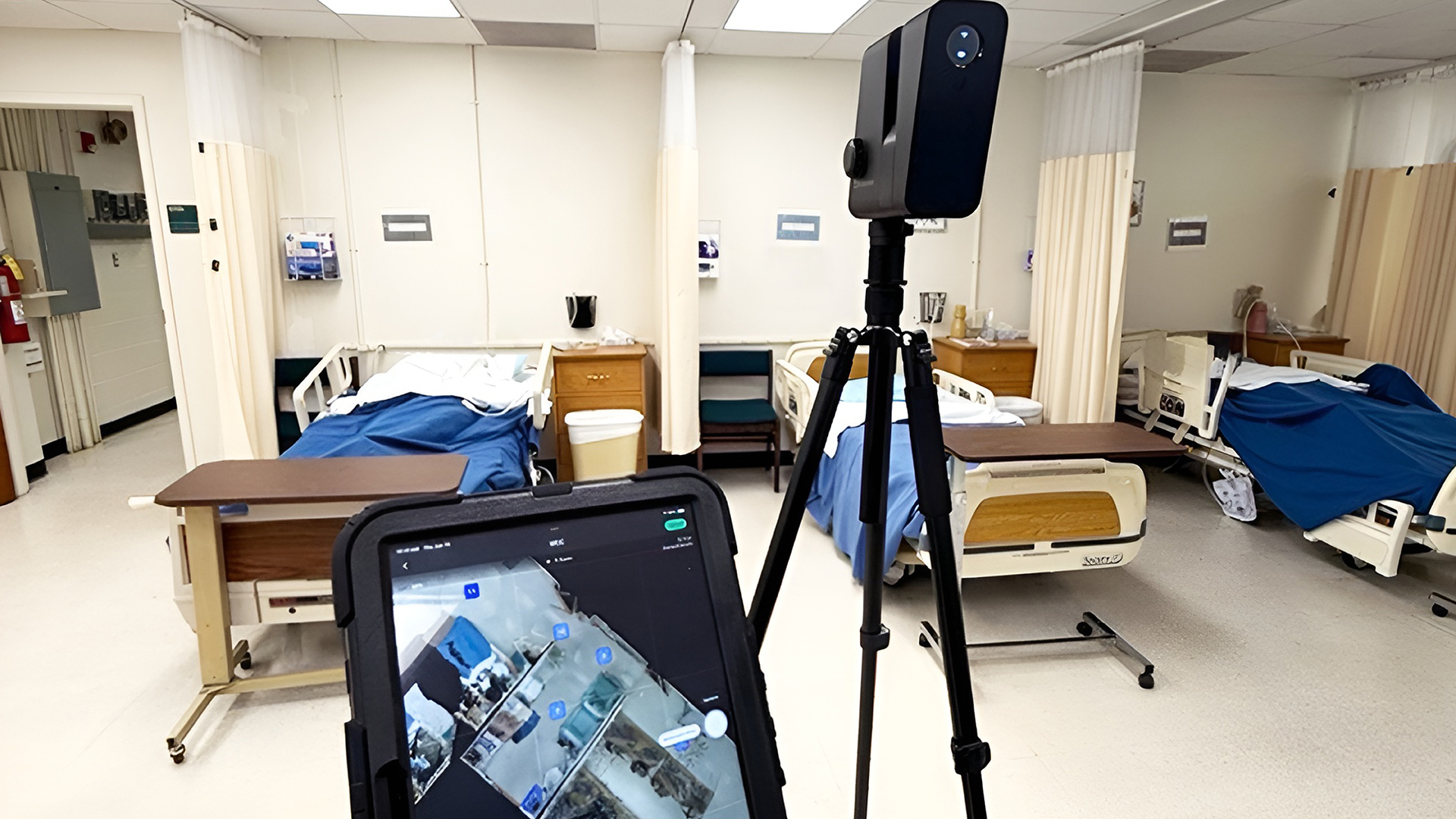Healthcare facilities are among the most complex environments to design. They must meet strict regulatory standards, operate without interruption, and accommodate intricate systems that support patient care. As the demands on these spaces continue to grow, the need for smarter and more precise tools to guide their design, renovation, and ongoing management becomes increasingly important.
Emerging technologies such as Artificial Intelligence (AI), Augmented and Virtual Reality (AR/VR), and 3D laser scanning are transforming the way architects and designers approach the design of healthcare and wellness environments. Among these, 3D scanning techniques such as LIDAR and Matterport are especially valuable for capturing detailed, real-time data of existing conditions.
By enabling faster and more accurate documentation with minimal disruption to daily operations, 3D scanning supports better planning, collaboration, and decision-making throughout the design and construction process.
This article explores the role of 3D laser scanning in healthcare architecture—what it is, why it matters, and how it is helping project teams respond to the unique challenges of today’s medical facilities with greater speed, clarity, and confidence.
WHAT IS 3D LASER SCANNING?
3D laser scanning is a technique to capture and create a digital image of a physical object or environment. It uses a non-contact, non-destructive device that emits a light or laser source to measure distances and capture a set of 3D coordinates. These coordinates for a point-cloud, which represents the scanned space in high detail.1
Use the data collected through 3D scanning to generate various outputs, including 3D meshes, models, and floor plans. These outputs can be integrated with Building Information Modeling (BIM) software to support design and documentation processes.2
UNIQUE CHALLENGES IN HEALTHCARE
Healthcare projects present a rare combination of complexity, sensitivity, and precision. These conditions make healthcare facilities an ideal setting to leverage the full capabilities of 3D laser scanning. Unlike traditional documentation methods, scanning can capture detailed information quickly and accurately, without interrupting ongoing operations.
What sets healthcare apart is not just the complexity of the environment, but the high stakes involved in even minor design errors or delays. Whether navigating tight above-ceiling conditions, coordinating around occupied spaces, or preparing for phased renovations, design teams need dependable data from the very beginning. 3D laser scanning helps meet that need by providing a reliable foundation for confident decision-making at every stage of the project. Here’s how 3D laser scanning benefits and addresses these challenges.
KEY BENEFITS OF USING 3D LASER SCANNING IN HEALTHCARE ARCHITECTURE
- Rapid data collection and less work-flow disruption
3D laser scanners collect highly accurate data faster than traditional methods.3 Shutting down hospital spaces to measure and document conditions manually can significantly disrupt workflow and is often not feasible. With 3D scanning, data can be captured in a single visit, preventing disruptions and eliminating the need for repeat site visits, ultimately saving up to 50% in time and cost.4 - Higher accuracy and detailed documentation
The need for accurate documentation is greater in healthcare spaces due to stricter building codes and the wide variety of equipment used in the industry. 3D laser scanners are highly precise and can produce digital twins of existing spaces. These models can be converted into point cloud file and used as underlays in BIM software to document existing conditions.5 - Enhanced collaboration and coordination
After scanning the existing conditions, store the data in the cloud and use it as a virtual walkthrough for reference during documentation. This 3D point cloud model can be shared with all stakeholders to support faster collaboration and coordination. Decisions can then be made based on accurate data and real site conditions. - Visualization for users
Healthcare facilities can offer virtual tours for patients and visitors to explore before their visits. This provides an opportunity to promote transparency and build trust by showcasing advanced technologies and patient-friendly spaces.
BEST PRACTICES FOR 3D LASER SCANNING IN HEALTHCARE FACILITIES
To get the most value from 3D laser scanning in healthcare environments, it’s important to approach the process with careful planning and coordination. The following best practices can help ensure accurate results while minimizing disruptions.
- Define a clear scope and objectives
Identify the areas and spaces that require scanning. If available, study existing floor plans in advance to familiarize yourself with the layout. Involve all key stakeholders early in the process to determine specific goals and make sure the scanning effort aligns with the overall needs and expectations of the project. - Plan the scan path
Develop a scanning path that covers all required spaces. Scan in a logical, sequential order to maintain good connectivity between scan points. Keep scan points within 5-8 feet of each other and ensure they remain within a clear line of sight.6 - Coordinate time and site access
Work with healthcare staff to schedule scanning during periods of low activity in order to minimize disruptions. Evaluate spaces ahead of time to identify potential obstacles and plan for efficient data collection. - Ensure privacy and compliance
Obtain all necessary permissions from hospital administration prior to scanning. Take care to avoid capturing any patient-identifiable information in the scan data to ensure compliance with privacy regulations.
CONCLUSION
3D laser scanning is poised to become an integral part of healthcare architecture, especially as it begins to integrate with emerging technologies like Artificial Intelligence (AI) and Augmented Reality (AR). AI will enhance the speed and efficiency of data processing, automate error detection, and improve overall accuracy. Meanwhile, AR will create immersive, virtual environments for training and maintenance, providing hands-on learning opportunities for healthcare staff.
Together, these advancements will make 3D scanning more interactive, more precise, and more accessible—ultimately expanding its use across a broader range of healthcare facilities.
- Haleem, A., Javaid, M., Singh, R. P., Rab, S., Suman, R., Kumar, L., & Khan, I. H. (2022). Exploring the potential of 3D scanning in Industry 4.0: An overview. International Journal of Cognitive Computing in Engineering, 3, 161–171. https://doi.org/10.1016/j.ijcce.2022.07.009 // https://go.matterport.com/getstarted.html ↩︎
- Autodesk. (n.d.). 3D laser scanning: Unleashing the power of precision. https://www.autodesk.com/solutions/3d-laser-scanning ↩︎
- Shults, R., Levin, E., Habibi, R., Shenoy, S., Honcheruk, O., Hart, T., & An, Z. (2019). Capability of Matterport 3D camera for industrial archaeology sites inventory. International Archives of the Photogrammetry, Remote Sensing and Spatial Information Sciences, XLII-2/W11, 1059–1064. https://doi.org/10.5194/isprs-archives-XLII-2-W11-1059-2019 ↩︎
- Matterport. (n.d.). Get started with Matterport. https://go.matterport.com/getstarted.html ↩︎
- Autodesk. (n.d.). 3D laser scanning: Unleashing the power of precision. https://www.autodesk.com/solutions/3d-laser-scanning ↩︎
- Matterport. (n.d.). How to Determine the Scan Path. https://support.matterport.com/s/article/How-to-Determine-the-Scan-Path?language=en_US ↩︎

